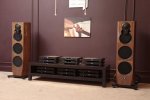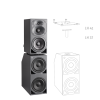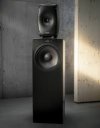The best sound for 2 channels can be gained by :
1. Extensive listening to find the correct place in the room for the main loudspeakers, using the tunemethod.
Here is how to do it :
2. After this is done correctly, you will find that the correct placement of the two active subwoofers in stereo is exactly the same place as your main loudspeakers - i.e. right below your main speakers.
3. After recognizing this - one understands that the best sound option is to have the active subwoofer inbuilt in the same cabinet as the main speaker - a big active floorstander .
So, to answer your question — if you want a pitch accurate sound from the whole audible frequency area, separate subwoofers is not the most optimal choice, but it might be practical.
Also, combining two separate subs with two small main loudspeakers with a 5 inch midbass , youre gonna get distortion at around 100 Hz when playing loud, and you cant cross over any higher in freq than about 100 Hz , because of the distance sub- to main loudspeaker is to long.
————-
Edit : in cases where you only have one subwoofer - because of wavelengths of sound is longer at lower frequencies, you have much more freedom in placement of a single subwoofer if your main loudspeaker can play music down to maybe 40 Hz without trouble . In this case, crossing the sub at 40 Hz with a steep filter ( more than 36 dB/oct ) you have a better opportunity to preserve the tonal pitch in the bass region.
The key to good bass fidelity is always to have the main loudspeakers playing bass as good as it gets even without subwoofers , with the correct placement in the room and with the use of proper loudspeaker stands. You have to do this even before thinking about adding subwoofers.
A bass guitarr plays frequencies from 40-8000 KHz , its not separated in only deep bass area - real instruments are functioning very different from sine sweeps or test tones.



